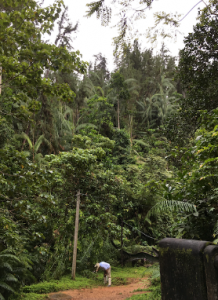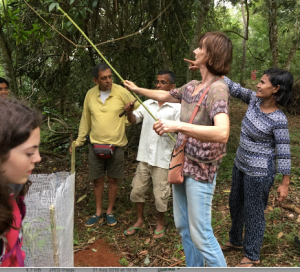Serrena in Year 11 discusses the geography and struggles of Sri Lanka that she learnt about and witnessed when she was on a school trip there this summer.
Environmental Geography:
Sri Lanka is a teardrop-shaped island, located in the Indian Ocean with different climatic conditions across this small country. Its coastal areas are around 0–30m above sea level whilst its central highlands are 300–500m above sea level with the highest point in Sri Lanka, Pidurutalagala, at 2524m above sea level. These differing altitudes result in different climates: in the coastal areas there is hotter weather with more convectional rainfall, whereas the central highlands are cooler with more relief rainfall. The cold, wet weather of the central highlands has resulted in an area called Nuwara Eliya being referred to as “Little England”.
Sri Lanka’s climate is also influenced by monsoons: the northeast monsoon (December to February), and the southwest monsoon (May to September). When the land heats up and low pressure is caused by the rising, hot air, cooler wind from the ocean is drawn in and brings with it heavy rainfall for the country. In Sri Lanka, the rivers naturally flow more towards the southern, wet zone but there has been human intervention to divert the flow of rivers towards the north of the country where there are dams.
The Sinharaja Rainforest:
 The Sinharaja Forest Reserve is a national park and a biodiversity hotspot in the southwest of Sri Lanka. It has been designated a Biosphere Reserve and World Heritage Site by UNESCO. There are 211 woody trees and lianas so far identified in the reserve, 66% of which are endemic, 20 of Sri Lanka’s 26 endemic birds are found here as well as half of Sri Lanka’s endemic mammals and butterflies.
The Sinharaja Forest Reserve is a national park and a biodiversity hotspot in the southwest of Sri Lanka. It has been designated a Biosphere Reserve and World Heritage Site by UNESCO. There are 211 woody trees and lianas so far identified in the reserve, 66% of which are endemic, 20 of Sri Lanka’s 26 endemic birds are found here as well as half of Sri Lanka’s endemic mammals and butterflies.
Human Impacts:
Lots of plants are cut illegally – the agarwood plant is fragrant and is stolen for use in cosmetics and perfumes, venivel creepers are taken for medicinal uses and the rattan plant is stolen for furniture. Precious gems are also illegally extracted from the site for jewellery. Pesticides left by people trying to grow certain plants to steal them lead to bioaccumulation. Contractors open up routes to facilitate logging operations and, although no felling is permitted within 1.6km of the reserve boundary, this renders the reserve more accessible to illicit timber operations. The planting of Honduran mahogany Swietenia macrophylla along abandoned logging trails as an enrichment species leads to the displacement of natural species, especially as it is a prolific seed producer.
The future of the site:
There are concerns over the future of the conservation of the site and its biodiversity as, despite being a UNESCO world heritage site, many people are illegally damaging it. Additionally, if global warming leads to more erratic and shorter monsoons, the plants will receive less water for photosynthesis which subsequently leads to less respiration and less growth.
Economic Geography:
Sri Lanka’s island status and ports allow it to have good trade relations with other countries. Its main exports are rubber, tea and coconut and its smaller exports are spices as well as minerals and gems.
Tourism:
Jobs in Sri Lanka are becoming increasingly based in the tertiary sector as it develops. There is Chinese investment in Sri Lanka: the government has taken a loan from the Chinese government to build a new harbour airport and highway as well as a new artificial island in Colombo called Port City. This new artificial island will provide jobs for locals as well as bring in lots of tourist revenue as new hotels will be built.
A growing tourist industry in recent years has allowed the country to recover after its development was hindered by a civil war. However, despite a growing tourism industry in Sri Lanka, upon visiting a hotel school on our trip and talking to the young men there who aspire to work in hotels we discovered that the vast majority of them want to work abroad. This may be due to a desire to see how other hotel industries work but Sri Lanka faces a larger issue of skilled workers leaving the country for higher salaries in the West.
1.2 million Sri Lankans work abroad and send money back home, whilst economic issues can also force women to work abroad. Women in rural areas who struggle to support their families have far fewer opportunities for employment in Sri Lanka compared to areas such as the Middle East. For example, there are 1.5 million Asian domestic workers in Saudi Arabia.
Social Geography:
Education:
Education is free in Sri Lanka and subsequently there is a 94% literacy rate. In Sri Lanka there are only spaces for around 10% of students to go to university. This lack of universities and increased competition for spaces in higher education leads to many parents feeling forced to send their children to tuition to give them the best chance possible of getting into university. This issue is exacerbated by the fact that school finishes at around lunchtime in Sri Lanka and children are unoccupied in the afternoon, a time when many school teachers will run their own private tuition. This leaves bright children, in a country where the average wage is USD $12,768, whose parents cannot afford to send them to tuition at a disadvantage compared to students whose parents have a larger disposable income. As parents feel compelled to allocate part of their income to their child’s tuition, they face an opportunity cost of giving their children a better chance of getting into university or having the financial means to afford a better quality of life for their family.
Culture:
There are people of many different religions in Sri Lanka who peacefully co – exist. As religious studies is a compulsory subject up until 16 in the Sri Lankan schooling system, the religious tensions of the civil war are unlikely to resurface and students are more tolerant.
Polwathatha Eco lodge:
 This Eco lodge encourages ecotourism.
This Eco lodge encourages ecotourism.
- It produces its own tea and coffee
- It has a community produce section and employs many locals to give them a source of income
- They collect polyethylene plastic and give it to a place in Digana where the plastic is recycled
- They give kitchen waste to the wild pigs which uses up the kitchen waste while maintaining biodiversity
- To maintain local culture and show tourists a non – westernised and authentic Sri Lankan experience they provide homestays for visitors
During our community stay in Digana local women have small plots of land where they can plant crops and sell them to gain a source of income and become independent, furthering the emancipation of women in rural areas of Sri Lanka.
When we visited a roadside rural restaurant, we realised that many people in rural areas lead sustainable lifestyles and their low income means they aim to have minimal waste. For example, coconuts are fully grated inside to provide food for the restaurant whilst the husk is used for building thatched rooves.
Evaluation
I found this trip visiting rural areas to be a humbling experience for someone who lives in a busy city like me for a few reasons:
- The resourcefulness of Sri Lankans makes up for their lack of technological advancements in comparison to Western, developed nations;
- The resilience of the people we met in the face of adversity; the absence of a social benefit system after tsunamis have caused vast devastation in Sri Lanka in the past two decades and a civil war that lasted 25 years disrupted the lives of thousands of Sri Lankans, displacing an estimated 800,000 people;
- The incomparable hospitality of our host families, drivers and everybody we met. There is a huge sense of community in rural Sri Lanka that left a lasting impact on my outlook in life.

